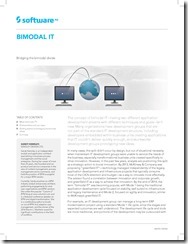 I wrote a paper a few months back on bimodal IT: a somewhat controversial subject, since many feel that IT should not be bimodal. My position is that it already is – with a division between “heavy” IT development and lighter-weight citizen development – and we need to deal with what’s there with a range of development environments including low-code BPMS. From the opening section of the paper:
I wrote a paper a few months back on bimodal IT: a somewhat controversial subject, since many feel that IT should not be bimodal. My position is that it already is – with a division between “heavy” IT development and lighter-weight citizen development – and we need to deal with what’s there with a range of development environments including low-code BPMS. From the opening section of the paper:
The concept of bimodal IT – having two different application development streams with different techniques and goals – isn’t new. Many organizations have development groups that are not part of the standard IT development structure, including developers embedded within business units creating applications that IT couldn’t deliver quickly enough, and skunkworks development groups prototyping new ideas.
In many cases, this split didn’t occur by design, but out of situational necessity when mainstream IT development groups were unable to service the needs of the business, especially transformational business units created specifically to drive innovation. However, in the past few years, analysts are positioning this split as a strategic action to boost innovation. By 2013, McKinsey & Company was proposing “greenfield IT” – technology managed independently of the legacy application development and infrastructure projects that typically consume most of the CIO’s attention and budget – as a way to innovate more effectively. They found a correlation between innovation and corporate growth, and greenfield IT as a way to achieve that innovation. By the end of 2014, the term “bimodal IT” was becoming popular, with Mode 1 being the traditional application development cycle focused on stability, well suited to infrastructure and legacy maintenance and Mode 2, focused on agility and innovation, similar to McKinsey’s greenfield IT.
Read on by downloading the paper from Software AG’s site; right now, it looks like registration isn’t required.
